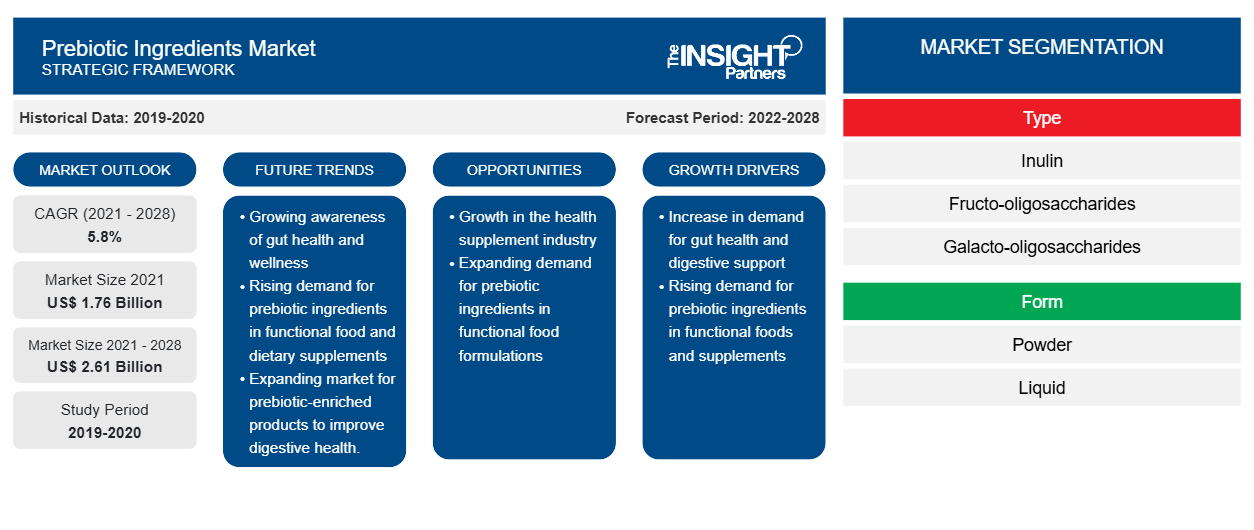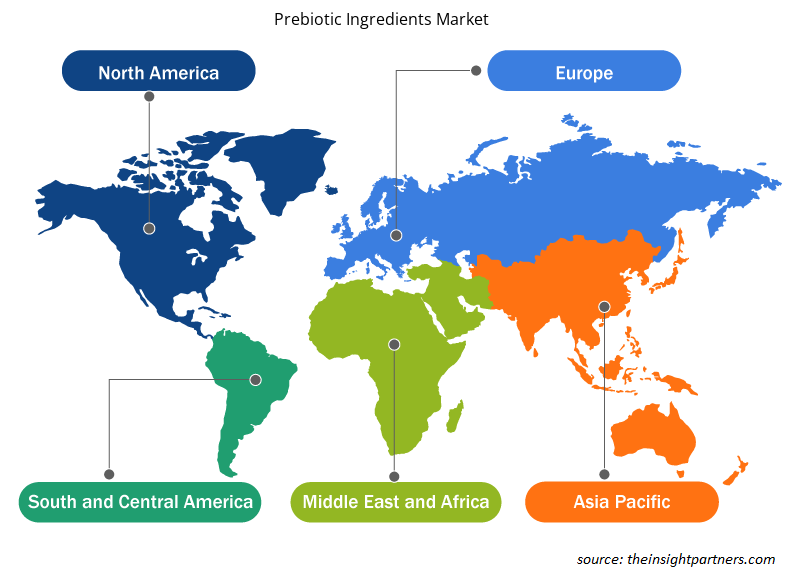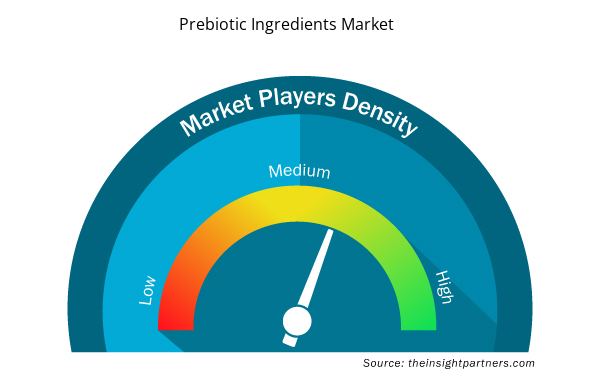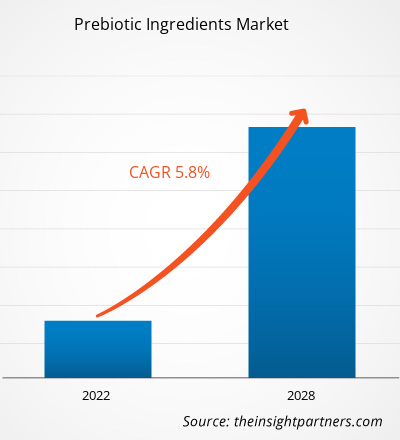[Research Report] The prebiotic ingredients market is expected to grow from US$ 1,758.40 million in 2021 to US$ 2,607.72 million by 2028; it is expected to grow at a CAGR of 5.8% from 2022 to 2028.
Prebiotics are compounds in food that induce the growth or activity of beneficial microorganisms such as bacteria and fungi. Fermentation is the main mechanism of action by which beneficial bacteria use prebiotics in the colon. Prebiotics play a significant role in preventive healthcare as the rising popularity of fiber-rich nutraceutical supplements among sports enthusiasts and athletes to build their stamina and endurance further boosts the demand for prebiotic ingredients. Thus, rising awareness regarding preventive healthcare is boosting the prebiotic ingredients market growth.
Asia Pacific held the largest prebiotic ingredients market share in 2021, while other developing regions, such as the Middle East & Africa, are expected to grow significantly in the forecast period. The market growth is attributed to increasing gut health and immune health disorders coupled with growing digestive diseases. The Asian countries are inclining toward adopting healthy and nutritious food items and beverages to improve gut health. Hence, inclination towards adopting healthy food is driving the growth of the prebiotic ingredients market.
Customize This Report To Suit Your Requirement
You will get customization on any report - free of charge - including parts of this report, or country-level analysis, Excel Data pack, as well as avail great offers and discounts for start-ups & universities
Prebiotic Ingredients Market: Strategic Insights

- Get Top Key Market Trends of this report.This FREE sample will include data analysis, ranging from market trends to estimates and forecasts.
Customize This Report To Suit Your Requirement
You will get customization on any report - free of charge - including parts of this report, or country-level analysis, Excel Data pack, as well as avail great offers and discounts for start-ups & universities
Prebiotic Ingredients Market: Strategic Insights

- Get Top Key Market Trends of this report.This FREE sample will include data analysis, ranging from market trends to estimates and forecasts.
Impact of COVID-19 Pandemic on Prebiotic Ingredients Market
The COVID-19 pandemic brought unprecedented challenges for many sectors in early 2020. Lockdowns, border restrictions, travel bans, manufacturing discontinuation, and other safety measures rolled out by governments as per the guidelines of the WHO and national health ministries hampered the manufacturing operations. However, the COVID-19 outbreak positively impacted the market as consumers increasingly were seeking natural and safer alternatives to keep themselves healthy and strengthen their immune systems. The demand for dietary supplements increased dramatically during the initial months of the COVID-19 pandemic. Moreover, as people stayed at home due to the government mandates, they focused on their health and fitness, stimulating the demand for prebiotics during the COVID-19 pandemic.
Market Insights
Rising Demand for Prebiotic Ingredients in Food & Beverages Sector
The popularity of prebiotics is rising in the food & beverages industry due to their application in nutritional bars, dairy products, health drinks, mineral supplements, breakfast cereals, bakery goods, confectioneries, green foods, and infant formulas. In November 2018, Kellogg company launched a new cereal, under the brand name HI! Happy Inside, including prebiotics and probiotics, as a part of its gut-boosting digestive products line-up. Further, inulin is widely utilized in food processing as it is a good and healthy substitute for fat and sugar. Major milk-producing countries such as the US, India, and China utilize prebiotics to provide desired texture to the final products and make sugar-free dairy products. Furthermore, infant formula or baby food contains various prebiotic ingredients, including galacto-oligosaccharides, fructo-oligosaccharides, and polydextrose. These are the factors driving the growth of the prebiotic ingredients market.
Type-Based Insights
Based on type, the prebiotic ingredients market is segmented into inulin, fructo-oligosaccharides (FOS), galacto-oligosaccharides (GOS), mannan-oligosaccharides (MOS), and others. The inulin segment is projected to register the largest share during the forecast period. Manufacturers use it in processed food and beverages, dietary supplements, and animal feed to replace sugar, fat, and flour. In the US in 2018, the Food and Drug Administration approved inulin as a dietary fiber ingredient to improve the nutritional value of manufactured food products. Moreover, the propelling demand for natural products increases the demand for prebiotic inulin worldwide. The growth of the inulin segment is driven by the rising application in various industries, fueling the growth of the prebiotic ingredients market.
Form-Based Insights
Based on form, the prebiotic ingredients market is segmented into powder and liquid. The powder segment is projected to register a higher CAGR in the market during the forecast period. The powder form made distribution easy and utilization of prebiotic consumption. The benefit of using prebiotic powder for livestock production has been gaining popularity as the powder prebiotics are accessible to consume at any stage of life of the livestock. Also, the increasing productivity of meats, eggs, and milk increases the demand for powder prebiotics.
Application-Based Insights
Based on application, the prebiotic ingredients market is segmented into functional food & beverages, dietary supplements, animal feed, and others. The dietary supplements segment is projected to register the highest CAGR in the market during the forecast period. The rising demand for preventive medicines, a growing number of digestive ailments among the elderly, and the lack of a balanced diet are likely to increase product demand in the dietary supplement industry. Consumers increasingly prefer prebiotic-based food supplements owing to the growing adoption of unhealthy diets.
The key players operating in the prebiotic ingredients market are BENEO GmbH; COSUCRA; DuPont Nutrition & Biosciences; Clasado Ltd.; Nexira; Ingredion Incorporated; SOLACTIS; Cargill, Incorporated.; Sensus; and Roquette Frères. These players are engaged in developing products with reduced health risks to meet emerging consumer trends and abide by regulatory frameworks. They are involved in mergers and acquisitions, business expansions, and partnerships to expand their market share.
Prebiotic Ingredients Market Regional Insights
Prebiotic Ingredients Market Regional Insights
The regional trends and factors influencing the Prebiotic Ingredients Market throughout the forecast period have been thoroughly explained by the analysts at Insight Partners. This section also discusses Prebiotic Ingredients Market segments and geography across North America, Europe, Asia Pacific, Middle East and Africa, and South and Central America.

- Get the Regional Specific Data for Prebiotic Ingredients Market
Prebiotic Ingredients Market Report Scope
| Report Attribute | Details |
|---|---|
| Market size in 2021 | US$ 1.76 Billion |
| Market Size by 2028 | US$ 2.61 Billion |
| Global CAGR (2021 - 2028) | 5.8% |
| Historical Data | 2019-2020 |
| Forecast period | 2022-2028 |
| Segments Covered |
By Type
|
| Regions and Countries Covered | North America
|
| Market leaders and key company profiles |
Prebiotic Ingredients Market Players Density: Understanding Its Impact on Business Dynamics
The Prebiotic Ingredients Market market is growing rapidly, driven by increasing end-user demand due to factors such as evolving consumer preferences, technological advancements, and greater awareness of the product's benefits. As demand rises, businesses are expanding their offerings, innovating to meet consumer needs, and capitalizing on emerging trends, which further fuels market growth.
Market players density refers to the distribution of firms or companies operating within a particular market or industry. It indicates how many competitors (market players) are present in a given market space relative to its size or total market value.
Major Companies operating in the Prebiotic Ingredients Market are:
- Beneo GmbH
- COSUCRA
- DuPont
- Clasado Limited
- Nexira
Disclaimer: The companies listed above are not ranked in any particular order.

- Get the Prebiotic Ingredients Market top key players overview
Report Spotlights
- Progressive industry trends in the prebiotic ingredients market to help players develop effective long-term strategies
- Business growth strategies adopted to secure growth in developed and developing markets
- Quantitative analysis of the prebiotic ingredients market from 2022 to 2028
- Estimation of global demand for probiotics
- Porter's Five Forces analysis to illustrate the efficacy of buyers and suppliers operating in the industry
- Recent developments to understand the competitive market scenario
- Market trends and outlook, and factors governing the growth of the prebiotic ingredients market
- Assistance in the decision-making process by highlighting market strategies that underpin commercial interest, leading to the market growth
- Size of the prebiotic ingredients market at various nodes
- Detailed overview and segmentation of the market and the probiotics industry dynamics
- Size of the growth in various regions with promising growth opportunities
- Historical Analysis (2 Years), Base Year, Forecast (7 Years) with CAGR
- PEST and SWOT Analysis
- Market Size Value / Volume - Global, Regional, Country
- Industry and Competitive Landscape
- Excel Dataset


- Artificial Intelligence in Healthcare Diagnosis Market
- Maritime Analytics Market
- Nuclear Decommissioning Services Market
- Pharmacovigilance and Drug Safety Software Market
- Legal Case Management Software Market
- Point of Care Diagnostics Market
- Integrated Platform Management System Market
- Machine Condition Monitoring Market
- Europe Tortilla Market
- Blood Collection Devices Market

Report Coverage
Revenue forecast, Company Analysis, Industry landscape, Growth factors, and Trends

Segment Covered
Type, Form, and Application

Regional Scope
North America, Europe, Asia Pacific, Middle East & Africa, South & Central America

Country Scope
Argentina, Australia, Brazil, Canada, China, France, Germany, India, Italy, Japan, Mexico, Russian Federation, Saudi Arabia, South Africa, South Korea, United Arab Emirates, United Kingdom, United States
Frequently Asked Questions
Increasing consumers’ focus on preventive health driving global prebiotic Ingredient’s market. Over the past few years, the awareness regarding health and nutrition has increased significantly. Because of hectic work schedules and extended working hours, people pay less attention to their daily diet, health, and fitness. Ignorance about proper diet may lead to various health issues such as obesity, diabetes, and digestive problems. This drives people’s focus toward preventive health and dietary supplements that offer health benefits without harmful effects. Prebiotics-infused supplements are known for their ability to nourish human gut flora and significantly boost their metabolic activity, hence improving digestion, nutrition absorption, and immune systems while inhibiting harmful microbe growth. Mannan-oligosaccharides (MOS) are a special prebiotic ingredient that interferes with the binding and colony formation of pathogens. Thus, it acts as a blocking agent in the intestinal area. Moreover, prebiotic supplements may offer health benefits, such as decreasing anxiety and alleviating irritable bowel syndrome (IBS) symptoms. A healthy digestive system has been linked to mental health and immune response improvements. These factors are significantly boosting the demand for such ingredients among consumers, eventually boosting the growth of the prebiotic ingredients market.
Based on the application, functional food & beverages segment is projected to grow at the fastest CAGR over the forecast period. The growing popularity of functional food & beverages driving the prebiotic ingredients market. The increasing demand for functional food is due to increased health issues among the population. This is due to the increasing consumption of functional foods to maintain & promote the gut health. Hence the rising diseases & health issues further projected the rise in demand for functional foods during the forecast period.
Further, the fortified foods are gaining popularity across the globe owing to the increased awareness of benefits among the population. Fortified foods usually produced with adding nutrients in it. Hence, the adding of essential nutrients tends to prevent the chronic diseases such as diabetes, heart diseases, and cancer. Hence, the consumption of fortified food is increasing worldwide, and further fueling the prebiotic ingredients market.
Asia Pacific accounted for the largest share of the global prebiotic Ingredients market. Asia Pacific prebiotic ingredients market is segmented into China, India, Australia, Japan, South Korea, and the Rest of Asia Pacific. The market growth is attributed to increasing gut health and immune health disorders coupled with growing digestive diseases. The Asian countries are inclining toward adopting healthy and nutritious food items and beverages to improve gut health. Hence, inclination towards adopting healthy food is driving the growth of the prebiotic ingredients market. Further, the growing awareness about the health benefits of prebiotics in animal health are creating substantial demand for prebiotic-based feeds such as lactulose, mannan-oligosaccharide (MOS), inulin, soy fructo-oligosaccharide (FOS) and galacto-oligosaccharide (GOS). As livestock and farm animals contribute significantly to the food supply chain, the demand for prebiotic-rich animal feeds is expected to grow during the forecast period.
The major players operating in the global prebiotic Ingredients market are Beneo GmbH; COSUCRA; DuPont; Clasado Limited; Nexira; Ingredion; Solactis; Cargill, Incorporated; Sensus; Roquette Freres.
Rising demand for prebiotics in animal feed anticipate lucrative opportunities for the prebiotic ingredients market. Animal feed with prebiotics as an additive has been shown to increase the yield. Mannan-oligosaccharides are used in poultry feed as an alternative to antibiotics. Rising cases of digestive disorders in livestock, such as enteric infections and acidosis, further agitate the industry landscape. The numerous advantages of prebiotics on animal health, such as triggered animal growth rate, and milk and egg yield, are anticipated to drive the demand for prebiotics in animal feed.
Based on type, inulin segment has largest revenue share. Inulin is a starchy prebiotic fiber found in various fruits, vegetables, and herbs, including wheat, onions, bananas, chicory, artichokes, and asparagus. Insulins are a group of naturally occurring polysaccharides, a heterogeneous collection of fructose polymers whose flavor ranges from bland to subtly sweet. Manufacturers use it in processed food and beverages, dietary supplements, and animal feed to replace sugar, fat, and flour. In the US in 2018, the Food and Drug Administration approved inulin as a dietary fiber ingredient to improve the nutritional value of manufactured food products. Moreover, the propelling demand for natural products increases the demand for prebiotic inulin worldwide.
Trends and growth analysis reports related to Food and Beverages : READ MORE..
The List of Companies - Prebiotic Ingredients Market
- Beneo GmbH
- COSUCRA
- DuPont
- Clasado Limited
- Nexira
- Ingredion
- SOLACTIS
- Cargill, Incorporated
- Sensus
- Roquette Freres

 Get Free Sample For
Get Free Sample For